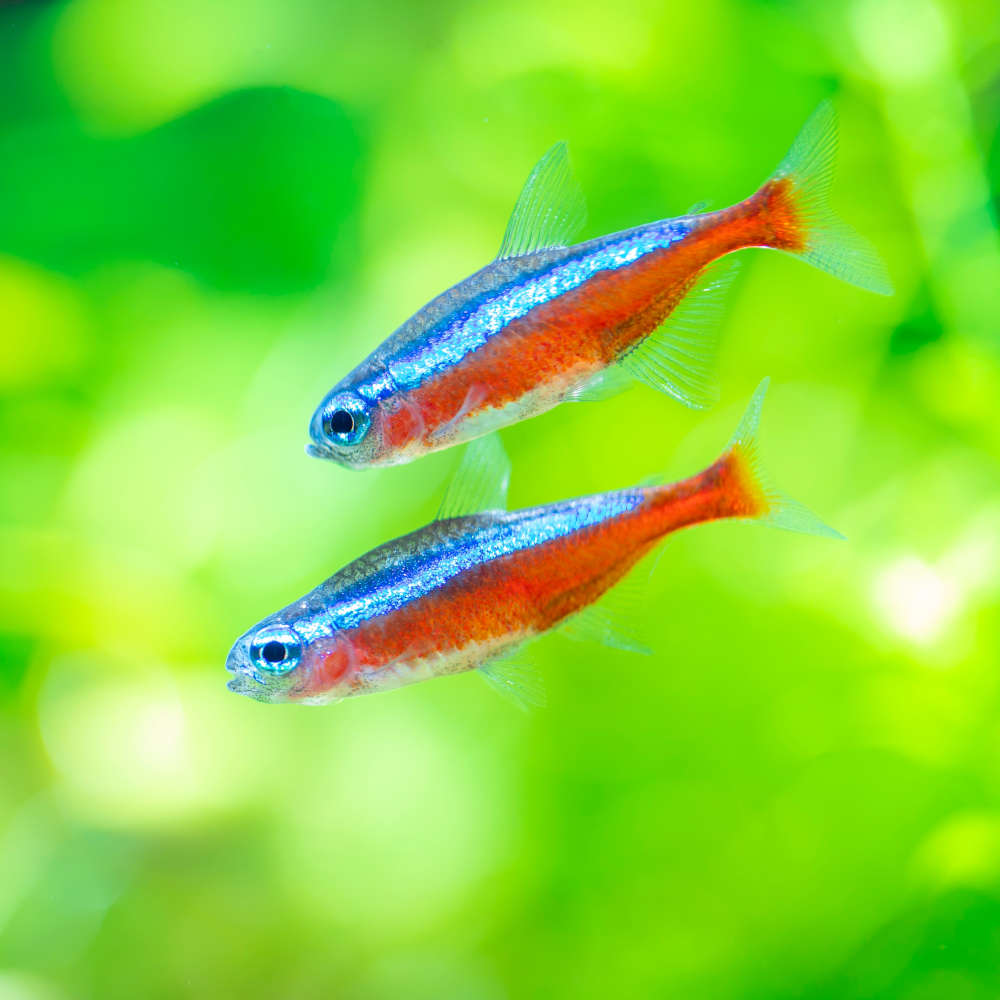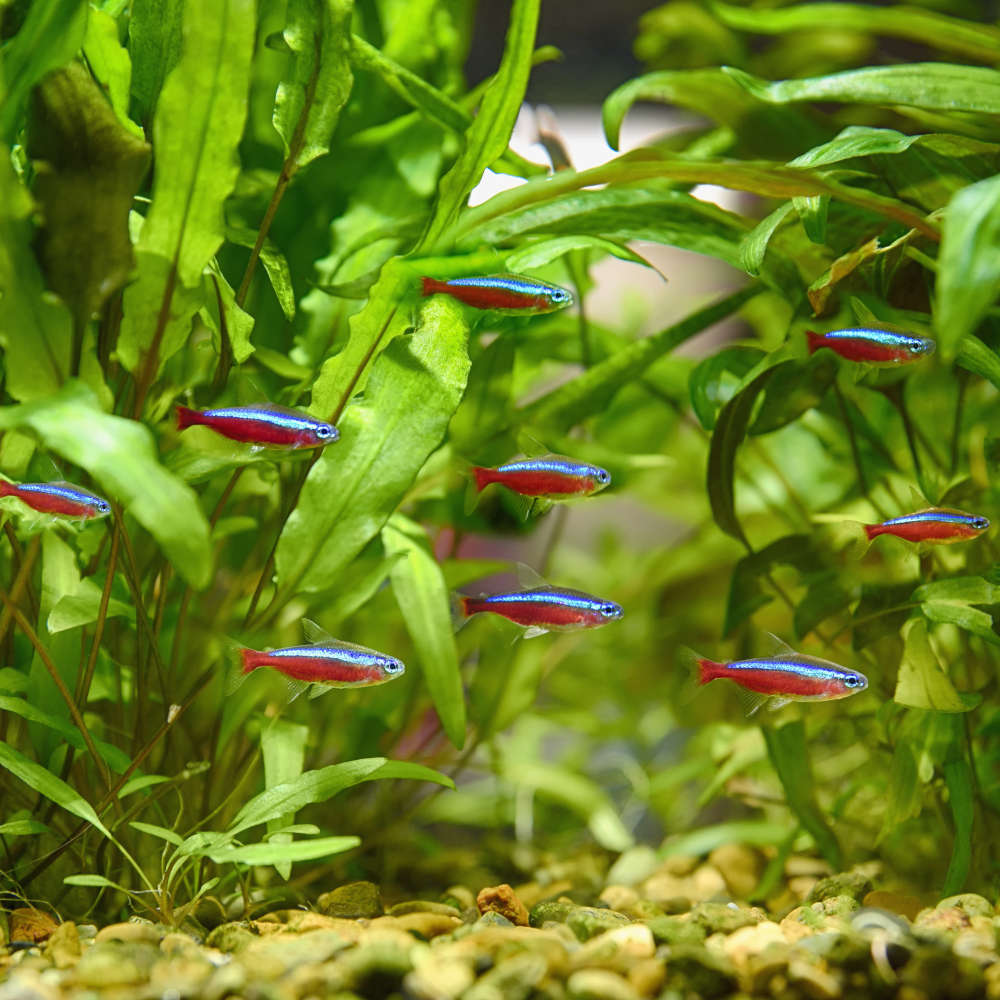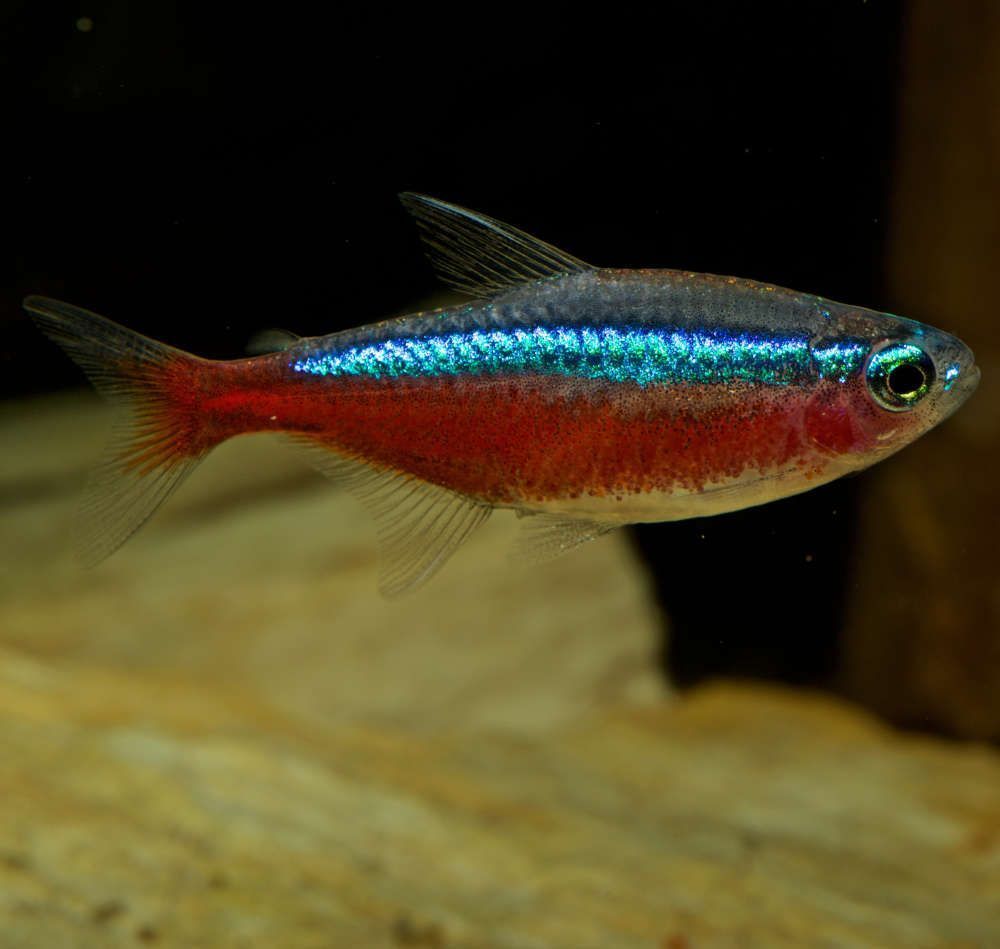If you want a colorful and small fin buddy for your freshwater tank, the cardinal tetra is here to steal your heart. This cute little fish is perfect for well-researched community tanks and proves to be a great choice for aquarists with a bit of experience.
Now, if you’re eager to bring it home, let’s get started!
What is a Cardinal Tetra?
Cardinal tetra is a beautiful looking freshwater fish that comes from the South American continent.
| Origin | Upper Orinoco and Negro River basins, South America |
| Order | Characiformes |
| Family | Characidae |
| Scientific Name | Paracheirodon axelrodi |
| Common Names | Cardinal tetra, Scarlet characin, Red neon |
| IUCN Red List Status | Least Concern |
| Appearance | Spindle-shaped fish, iridescent blue stripe, red below it, white belly, transparent fins |
| Size (Adult) | Around 2-3 cm (0.8-1.2 in) |
| Lifespan | Around 3-5 years |
| Temperament | Peaceful |
| Tank Level | Middle dweller |
| Water Temperature | 73-81 °F (23-27 °C) |
| pH Level | 4-6 |
| Water Hardness | Up to 12 dGH |
| Care Level | Intermediate |
| Minimum Tank Size | 30 gallons for 10 |
| Tank Environment | Dark sandy substrate, plants, decor, moderate flow, swimming space |
| Diet | Omnivorous with carnivorous preferences |
| Tank Mates | Own school, similar-sized, similar-tempered species |
What is the Natural Habitat for Cardinal Tetra?
Cardinal tetra hails from slow-flowing freshwater river basins of the upper Orinoco and its tributaries and Negro of Brazil, Colombia, and Venezuela, South America.
In the Negro River, it’s spotted around the stained brownish water with overhanging, thick, riparian vegetation around tree roots, leaves, and fallen branches.
In the Orinoco system, the species swim around the clear waters with dense aquatic plant growth and riparian vegetation.
According to the 2021 assessment of The IUCN Red List of Threatened Species, it’s given the Least Concern status.
What family of fish do Cardinal Tetra belong?
The tetra belongs to the Characidae family of the Characiformes order. Its scientific name is Paracheirodon axelrodi, and it’s popular worldwide as cardinal tetra, scarlet characin, and red neon.
Fun Fact: Cardinal tetra looks quite similar to neon tetra and green neon tetra. But the cardinal has more red coloration than the neon; hence, it is also called red neon tetra. The green neon tetra has a greenish-blue iridescent line up to the adipose fin, and the red is hardly noticeable.
How does Cardinal Tetra look?

Cardinal tetra has a blend of two colors and looks stunning with the combination. If you’re curious to know more about the looks of this bright little buddy, let’s start rolling!
What is the Size of Cardinal Tetra?
Cardinal tetra can reach a size of around 2-3 cm (0.8-1.2 in). According to some, it may reach up to 5 cm (2 in), but that depends on the fish’s genetics and may rarely happen.
What are the colors of Cardinal Tetra?
Cardinal tetra has a vertical electric blue neon stripe from its nose to the tail. Below that stripe, the fish is adorned with a wide, bright red stripe that slightly bleeds into the tail. The remaining fins are colorless and transparent. Its underbelly is white.
There’s a slight difference between the cardinal from different regions:
- The Negro river species is straighter, has a longer blue stripe that ends below the adipose fin base, and the red pigment goes a little further towards the belly.
- The Orinoco river species is slightly arched, has fewer red pigments near the ventral region, and the blue stripe ends before the adipose fin. This one looks a bit more chunky.
There are also other varieties of cardinal tetra:
- Albino cardinal tetra: It has a transparent body, muted red and blue stripes, and pink or purple eyes.
- Golden cardinal tetra: It mostly has a golden or opal-colored body. It’s not brightly colored.
What are the Features associated with Cardinal Tetra?
The tetra has a spindle-shaped body, a blunt nose, and a forked tail. The color of the fish changes depending on different lighting.
When the cardinal rests at night, its colors become dull. If your tetra shows dull colors during the day, it’s stressed or ill.
How do Cardinal Tetra males and females differ from each other?
The female cardinal has a fatter belly than the male. The male also has a hook protruding from his anal fin.
How do Cardinal Tetras behave in the aquarium?
Cardinal tetra is peaceful, docile, timid, and social. The schooling fast swimmer is diurnal and spends most of its time in the middle water levels. It loves to explore and shows the brightest colors in a school of 6-10 (minimum).
You’ll hardly see it get into fights. However, it can get a bit territorial during mating.
What is the Lifespan of Cardinal Tetra?
In the wild, the cardinal tetra hardly lives up to 1 year because of its lack of sense of danger. However, in captivity, it can live up to 3-5 years.
In my experience, if you give it top-notch care and support, it might even live up to 6 years.
On the other hand, without basic requirements, its lifespan may drastically drop.
Author’s Note: When you get a cardinal pet, ask the store whether it’s captivity-bred or wild-caught. Wild-caught specimens are pretty sensitive to water chemistry. So, be more careful with those.
How to take care of Cardinal Tetra in the Tank?

Now, if you’re wondering about the cardinal tetra’s care needs, let’s know everything in detail here.
What Tank Size should you have for Cardinal Tetra?
The cardinal tetra feels more secure in its own school, so make sure you get a bunch of them.
Some suggest getting a 20-gallon tank for a school of 6. However, a bigger school makes the fish happier and more brightly colored. So, it’s best to get a 30-gallon tank for a school of 10.
What type of Water Chemistry should you have for Cardinal Tetra?
To keep your cardinal healthy, you must provide it with the best water quality. So, monitor water chemistry and consistently follow these levels.
- pH Levels: 4-6
- Water Temperature: 73-81 °F (23-27 °C)
- Water Hardness: Up to 12 dGH
- Ammonia: 0 ppm
- Nitrite: 0 ppm
- Nitrate: Less than 30 ppm
What is the recommended Tank Environment for Cardinal Tetra?
Other than the water, you must also choose wisely what goes in the tank to mimic its natural habitat. So, let’s know every little detail…
Is substrate needed for Cardinal Tetra?
The cardinal tetra doesn’t spend long hours on the bottom, so many don’t care about the substrate choice. However, it’s best to use a dark sandy substrate to highlight the bright iridescent shades of your pet.
Are any Plants needed for Cardinal Tetra?
Plants are a must-have in your cardinal tetra tank to mimic its Amazonian biotope. Some great plants are java fern, Amazon swords, anubias, cryptocoryne, hornwort, and vallisneria.
Plants work as hiding spots for your fish. However, place the plants only at the sides. Keep the center clear for your fish to swim around.
Which type of Lighting is needed for Cardinal Tetra?
The characin feels comfortable in shaded regions. So, use dim lights in your tank. Otherwise, it’ll stress your pet and make it colorless. You can also use floating plants to reduce the amount of light reaching your fish.
What type of Décor is needed for Cardinal Tetra?
Some great choices of decor are rocks, stones, caves, snags, and overhangs. Whenever the middle-dweller feels unsafe, it can hide there.
Besides that, a large chunk of driftwood that reaches the middle column of the tank is also great. The tetra can hide behind it right away when necessary.
Moreover, add some branches, roots, and leaf litter to stain the water with tannin and mimic the blackwater creeks of its natural habitat.
Which type of filter is needed for Cardinal Tetra?
A canister filter works best for this tank. It doesn’t create too much flow and keeps the tank water in top-notch condition. You can add a mesh bag full of aquarium-safe peat to your filter to simulate blackwaters.
Along with that, perform water changes regularly and use test kits to maintain the water quality.
What is the Water Flow Rate required for Cardinal Tetra tank?
The fish feels the most comfortable in slow to moderate currents.
Can Cardinal Tetra jump out of the tank?
Yes, cardinals are great jumpers. So, use a tightly fitted tank lid to avoid losing fish from fatal jumps.
What is the Diet for Cardinal Tetra?
Though cardinal tetra accepts omnivorous feed, it loves carnivorous feed more. In fact, live and frozen feed helps your pet retain its bright colors.
In the wild, it munches on smaller invertebrates, fallen fruits, and filamentous algae. Here are some of the best food options for it:
- Brine shrimp
- Bloodworm
- Mosquito larvae
- Daphnia
- Moina
- High-quality flakes
- Finely chopped fruits
- Finely chopped vegetables (broccoli, cucumber, skinned peas)
Include 75% high-quality commercial feed in your fish’s diet. This will help meet its vitamin needs. Don’t go overboard with the live and frozen feed. Otherwise, it will become picky and reject other feeds.
If you can only feed your fish 1-2 times a day, feed it for around 5 minutes. Ideally, it’s best to feed it around 4 times a day for 3 minutes each.
Which Tank Mates are friendly with Cardinal Tetra?
Before you get the cardinal tetra other tank mates, ensure you have 10 of this tetra. Once that’s done, you can pick other peaceful, similar-sized community species for it like these:
- Other similar-sized and similar-tempered tetras (flame, glowlight, neon, black neon, serpae, red-eyed, and emperor tetra)
- Rasbora (harlequin, scissortail, phoenix, lambchop rasbora)
- Danio
- Molly
- Dwarf gourami (honey, sparkling gourami)
- Cory catfish (panda cory, pygmy cory)
- Hatchetfish
- Pencilfish
- Labyrinth fish
- Small armored catfish
- Peaceful dwarf cichlid (ram cichlid)
- Livebearer (Endlers, least killifish, guppy)
- Freshwater shrimp, snails, and crab that don’t fit your tetra’s mouth
Which Tank Mates to Avoid with Cardinal Tetra?
Don’t put cardinals together with the following types:
- Large, aggressive, and/or predatory species: They may try to eat your tetra.
- Boisterous species: They may terrorize your tetra with their high activity.
- Smaller invertebrates: Your tetra may eat them.
- Long-finned species: They may activate your tetra’s fin-nipping behavior.
Some species to avoid are:
- Scalaris
- Discus
- Betta
- Cichlid
- Freshwater angelfish
What are the Common Diseases associated with Cardinal Tetras?
Cardinal tetra is vulnerable to the most common freshwater fish disease like ich, columnaris, and fin rot. Other than that, here are a few other diseases it suffers from:
| Disease Name | Causes | Symptoms | Treatment |
|---|---|---|---|
| Neon Tetra Disease | Pleistophora hyphessobryconis microsporidian parasite | Spreading blemish or spot under dorsal fin, lumpy cysts, restlessness, color loss, swimming difficulties, curved spine | Incurable (try treating with methylene blue) |
| Velvet | Parasitic infection | Rapid breathing, flashing, clamped fin against the body, color loss, fatigue, appetite loss, yellow film on body, peeling skin | Increase water temperature, keep dimmed lights for days, add aquarium salt or malachite green or aldehyde medicine |
| Dropsy | Infection, poor water quality, stress | Bloated belly, scale protrusion, skin redness near fins and vents, ulcers | Quarantine, improve diet, perform regular partial water changes, and add medicine |
Quick Tip: Quarantine the fish before introducing it to the tank. Similarly, quarantine all other aquatic species and objects you introduce in the tank.
How to Breed a Cardinal Tetra?
It’s tricky to breed cardinal tetras. However, this species has been successfully bred in captivity. Here’s how you can do it too:
How to prepare a Breeding Tank for Cardinal Tetra?
Prepare a separate 30-40 gallon tank for group spawning (5 males and 5 females). Don’t use 5-gallon tanks – nano tanks have high water flow rates, which stresses the fish.
Maintain the following water chemistry:
- pH Levels: 5-6
- Water Hardness: 1-2 dGH
- Water Temperature: 75-82 °F (24-28 °C)
Ensure the tank is dimly lit, fill only 5-6 inches deep water, and add spawning mops and fine-leaved plants like Java moss for egg deposition.
You can also fix a mesh on the bottom with holes big enough to pass the eggs through but not the fish. For filtration, use a small air-powered sponge filter.
Where to keep different Cardinal Tetra while breeding?
Keep the male and female fish in different tanks and feed them with lots of live food. Select the 5 fattest females and the 5 brightest males and introduce them to the breeding tank.
Mating & Parent Fish Separation
The fish are supposed to spawn around midnight and lay 130-500 0.8 mm eggs. This happens even if your aquarium lights are on.
The female is an egg scatterer, and the male fertilizes them externally.
If you notice eggs in the morning, relocate the parent fish into the main tank. Otherwise, if there’s no mesh, they will eat the eggs or fry.
When do Cardinal Tetra eggs hatch?
The eggs hatch around 24-36 hours from being laid. The fry become free swimmers after 3-4 days. You can spot them at the bottom of your tank. Until then, they soak their egg yolk.
Keep the tank in complete darkness because the eggs and fry are light-sensitive. Once they grow up to a considerable size, introduce subdued light slowly.
Feed the free-swimming fry infusoria, hard-boiled egg yolk, and rotifers for a few days. Once they grow big enough, feed them baby brine shrimp and microworm.
Feed them chopped tubifex once they’re 6 weeks old or 1 cm long. Tubifex helps them grow faster.
At 3 weeks of age, the fry show their iridescent blue stripe. After 6-8 weeks, you can introduce the young fish to the main tank.
Breeding Tip: If the fish doesn’t breed in the group for several days, repeat the entire process but with one pair of male and female fish at a time. This increases the chances of spawning.
What are the buying tips for Cardinal Tetra?
Check for these signs to ensure the cardinals you get from the store are healthy:
- No white spots
- Intact fins
- Kept in dimly lit tank
- Has vibrant color
- Has good appetite
- No bloating
- Active and kept in a school
A word from FishInAquarium
If you get a school of cardinal tetras, they’ll mesmerize you with their synchronized swimming that looks like a moving sheet of color! Their curious yet shy nature, along with voracious appetites, is sure to make you swoon over them.
So, if you’re ready to show some love for this pet, share it with other enthusiasts. Let them know about it and also adopt a bunch of them!
Have more questions? Drop us an email and we’ll get back to you ASAP!


